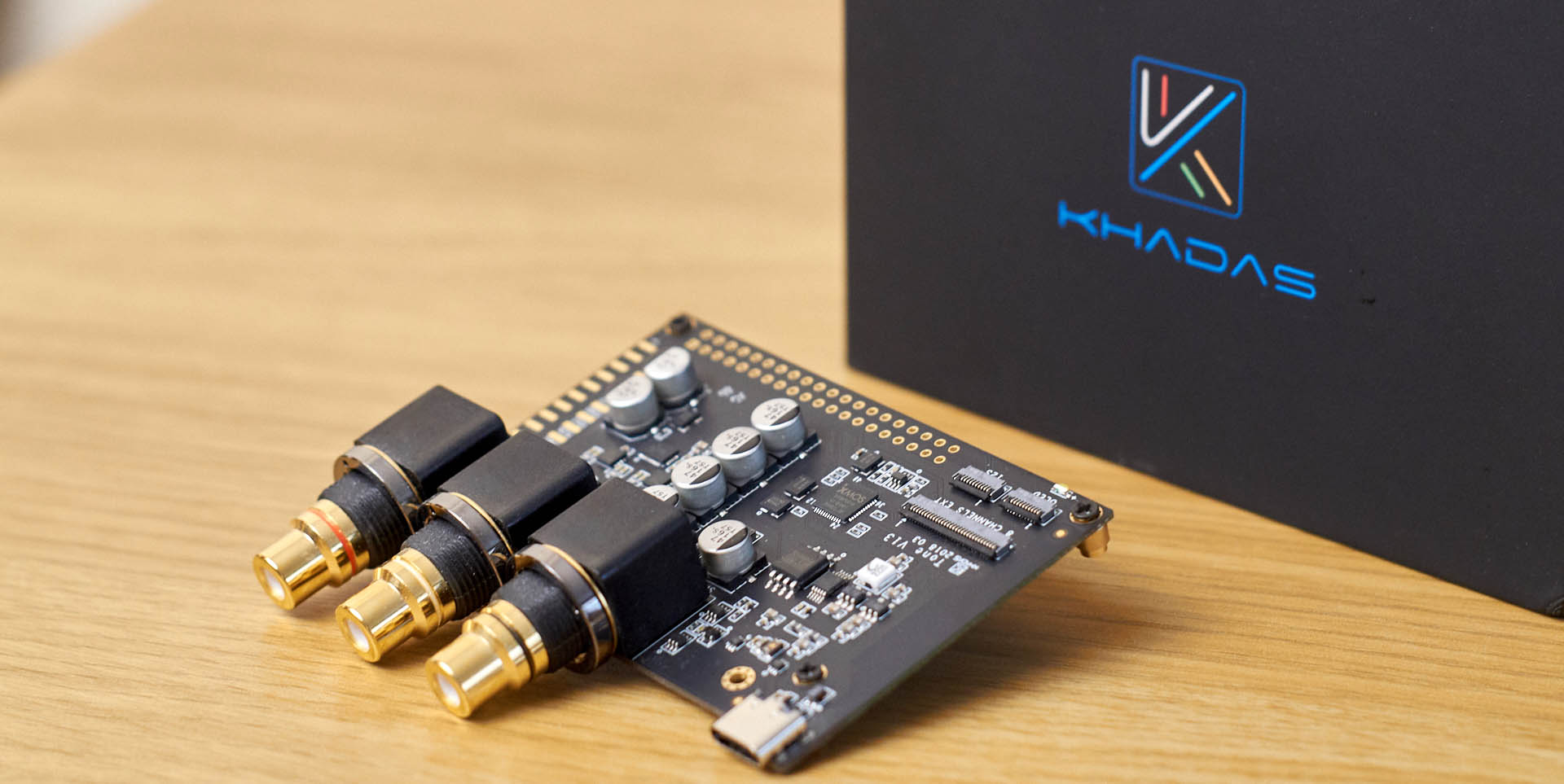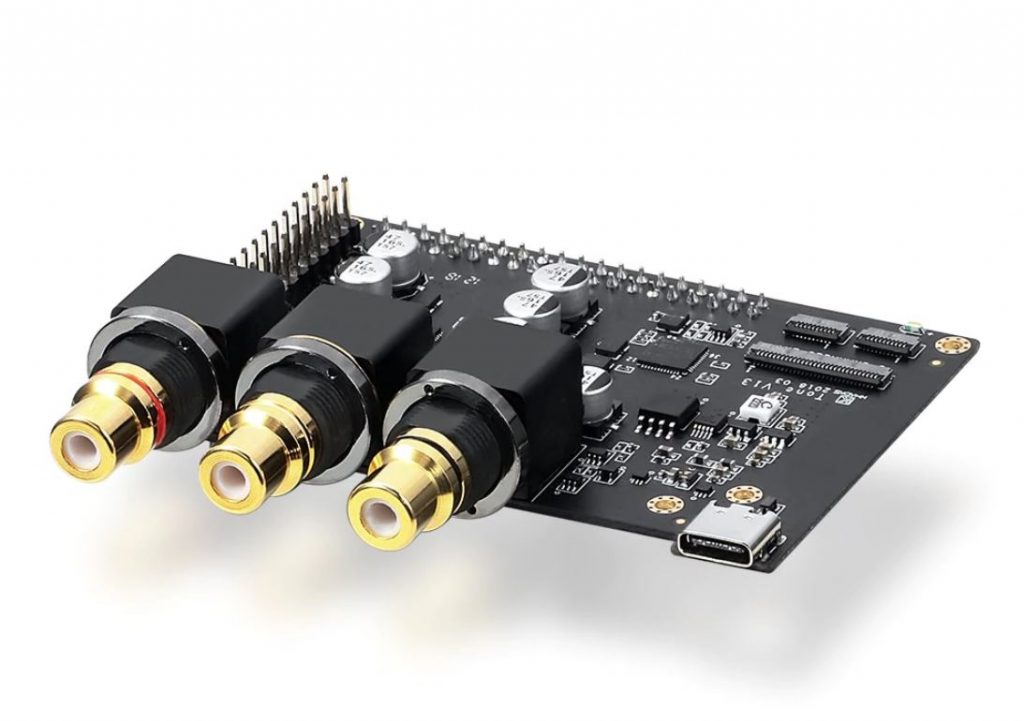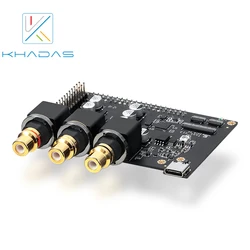Khadas Tone Board is a small and unassuming board, but it is actually a fully functional DAC. Why no case you ask? Because it’s primarily aimed at developers but there’s nothing stopping you from trying it out too. True, it doesn’t have a case but you can hook it to your PC or a phone and it will work right out of the box.
FUNCTIONALITY
This board is produced by a company named Khadas and its name is simply Tone Board. The whole board is made around very nice Sabre DAC chip ES9038Q2M and it retails for just $99 or 89€.
Now let’s talk about connectivity first. We have line-out through a pair of RCA connectors, as well as two digital inputs: coaxial and USB. A USB input is also doubling as a power source. You don’t have any means of switching inputs so it works this way – USB is a priority input and if any audio signal is detected there the DAC will prioritize it over Coaxial. Coaxial input will turn only if it receives an audio signal while USB input is not. For example, if you’re using USB just to power it. If Tone Board is connected to a PC via USB but you want to use Coaxial input, you don’t need to disconnect it physically, just pause your music and all other sounds on that PC and you’re immediately free to use Coaxial input.
I connected KTB (Khadas Tone Board) through USB and Windows 10 recognized it right away, no drivers needed. However, generic Windows driver is USB Audio 1.0 class and that means it is limited to 24bit/96kHz. If you want to fully utilize all the formats KTB supports, just head to the manufacturer’s website and fetch the driver. After that, your KTB will be happy playing PCM up to 32bit/384kHz as well as any DSD up to DSD256.
SOUND
Now that we got technicalities out of the way, let’s talk sound. Khadas Tone Board sounds very well balanced without any harshness you may get with some Sabre powered products. Let’s start with the bass. It’s very deep but fast and well-controlled. Bass notes sound deep and rumbling and are seamlessly melting into the mid-bass region which again rich and full. The story continues with mid-tones which sound full and rich with details creating present and weighty vocals. Going to the higher tones, they’re full of details but not overly bright or sharp in any way.
Because of everything mentioned above, listening to any instrument or vocals through KTB gives a full-bodied experience. It will not convey the airy feel of the recording as well as some other DACs but you wouldn’t notice that without a direct comparison with a more open and airy DAC like Schiit Modi 3. Some may even prefer this full and fluid presentation over the airiness and digging every last piece of information from the recording. Now add to that great dynamics, very decent sound-stage, and great instrument separation, and I think it’s safe to say that we have a full package here.
COMPARISON
As I mentioned above, Khadas Tone Board is not as open and airy as Schiit Modi 3 or Loxjie D10 for example. It makes up for it with its full, big, and lush sound. It’s up to you to prioritize. iFi Zen Dac is a bit more expensive but it’s worth considering. Sonically it sits somewhere in the middle, it can offer both weighty bass notes and vocals, as well as an airy and open soundstage.
CONCLUSION
Khadas Tone Board is more than a decent sounding device. When I first got it almost a year before this written review I was captivated by its sound quality and I made a raving video review. A year later it might not be the absolutely best sounding DAC in the price range, but it is darn close. Depending on the availability and pricing of competing models in your country, KTB is still an option well worth considering.







First of all, congratulations for your website and your detailed reviews. It is very useful and didactic. I appreciate very much the fact that the reviews focus on the listening experience versus the measurements.
I am writing to ask for advice, since I am in trouble.
I currently have the Fx Audio Dac X6, connected to my pc. I am happy with it, I like how it sounds, however after reading many forums and reviews, I am thinking of buying a dac that improves the sound and performance. I usually use Qobuz Studio and a collection of flac files from 16/44 to 24/192. I would also like to be able to play DSD files. In principle I would use it with a pc (usb) or with a raspberry pi (through usb or hifiberry digi+ pro).
With a budget of approximately € 100, these are the candidates.
– Topping d30
– Khadas tone board
– Schiit Modi 3
After seeing your and review and watching your videos about the Khadas Tone Board, I was almost decided by it, but now I am in doubt. With any of these dacs, will I notice much improvement in sound?
My equipment consists of: Fx Audio Tube 01 – * DAC – Kenwood KA 3020 – Technics sb-ch570 (in the future I will improve the speakers)
Thank you so much for everything. Regards!
Thanks Carlos. Sorry I didn’t answer earlier, somehow this message was not showing in notifications.
It’s always tough to say will a DAC, and by how much, improve things in someone else’s system I haven’t heard before. In your case, I would probably go for great Lusya Fever DAC – https://iiwireviews.com/fever-dac-a-25-game-changing-stick Its value is insane, it sounds better than Dragonfly Black and it’s a great place to start in my opinion. It is probably an even better DAC than Topping D30 is.
Will you be reviewing Soncoz LA-QXD1 when it launches? It’s supposedly made by the developer of Khadas Tone Board.
Honestly, this is the first time I hear about it. I have to dig in some more details about it before making that decision.
HI, I bought the tone board dac and I run it on window 7 through the usb port. Beautiful sound. Even a def man can hear the difference.
My trouble is that i can use it only a 24 bit / 192 000
How can I increase it to the maximum 32 bit / 384 000 ?
What should I do?
I believe that 24/192 is the maximum sample rate supported by the Windows mixer. If you want to achieve more, you would have to find a player able to take exclusive control over DAC (you check that box in the Windows audio panel and it lets the player override Windows audio mixing) than set the output inside the player to oversample to the maximum value supported by the DAC. I know that HQplayer can do this for example. However, I recommend using bit-perfect output instead (Foobar2000 player with exclusive mode for example) and letting the output match the bitrate and sample rate of the source material. It always sounds better to my ears when we don’t maddle with the original file data too much. Every DAC is doing internal hardware oversample anyway and it’s doing that better than Windows and most players.
I would like you to help me solve the following general question. What is the best way to connect DAC to a minicomputer: USB, SPDIF, I2S. I would like to choose out of the following variants:
Variant1: Raspberry Pi + Hifiberry DAC 2 HD (Hi end dac of hifiberry still not reviewed in your site)
Variant2 Raspberry PI + Kali reckloker + Pianodac (allo)
Variant3 Khadas SBC VIML3 + Khadas tone board directly conected to I2s
Variant4 Raspberry Pi + Digione spdif output + SPDIF DAC for example Khadas tone board
Variant5 Raspbery or VIML3 + USB noice eliminator + USB DAC
Hello Mr Stojanovic,
I would like to ask you again my previous question. It is mainly aimed to understand which type of connection of a DAC to a SBC is the best. The examples bellow are only to clarify what I mean.
I hope you will answer to my question and thank you in advance.
Best regards.
Bozhidar
I would like you to help me solve the following general question. What is the best way to connect DAC to a minicomputer: USB, SPDIF, I2S. I would like to choose out of the following variants:
Variant1: Raspberry Pi + Hifiberry DAC 2 HD (Hi end dac of hifiberry still not reviewed in your site)
Variant2 Raspberry PI + Kali reckloker + Pianodac (allo)
Variant3 Khadas SBC VIML3 + Khadas tone board directly conected to I2s
Variant4 Raspberry Pi + Digione spdif output + SPDIF DAC for example Khadas tone board
Variant5 Raspbery or VIML3 + USB noice eliminator + USB DAC
Hi Bozhidar, I was trying to come up with a useful answer last time without much success, until I finally forgot to answer altogether.
This is a tough one since I haven’t tried most of the mentioned devices. I did use Khadas Tone Board, but as a separate DAC connected via USB or SPDIF to the digital source, never on its own VIML3. I’m also currently using Pi + DigiOne to SPDIF input on any of my DACs. As far as digital sources go that sounds really good and smooth. But again, I never tried any of the I2S DAC boards so can’t really comment on them. I suppose it comes down mostly to the quality of the DAC implementation, much more than the connection used (I2S or SPDIF).
Sorry that I’m not of much help here, but I don’t want to speculate and give any advice based on theory or other people’s experience.
Hi Srboljub,
Thank you for the answer. Finally I will go for SBC and external DAC. I would like to ask you two more questions. I see in your answer that there is no significant difference between USB and SPDIF input in quality, but as there is difference in the types of the files, for example Topping S50 DAC:
USB IN: 44.1 kHz-768 kHz /16 bit – 32 bit
DSD64 – DSD512 (Native)
DSD64 – DSD256 (Dop)
OPT/ COAX IN: 44.1 kHz – 192kHz / 16bit – 24bit, DSD64(Dop)
It seems that for the future purposes USB input is better, am I right?
Second question does the USB noise eliminator obligatory.
Merry Christmas
Bozhidar
Yes, USB is definitely more future-proofed. That said, I’m comfortably using S/PDIF with most of my DACs since I never found commercial music in a resolution higher than 24/192 and I don’t think we’re going to see it anytime soon. But yes, if you like to play with extremely high resolutions and DSD, USB is the way to go.
Hi Srboljub,
Thank you very much for the help.
Želim vam zdravlje i puno sreće.
Bozhidar
Bulgaria